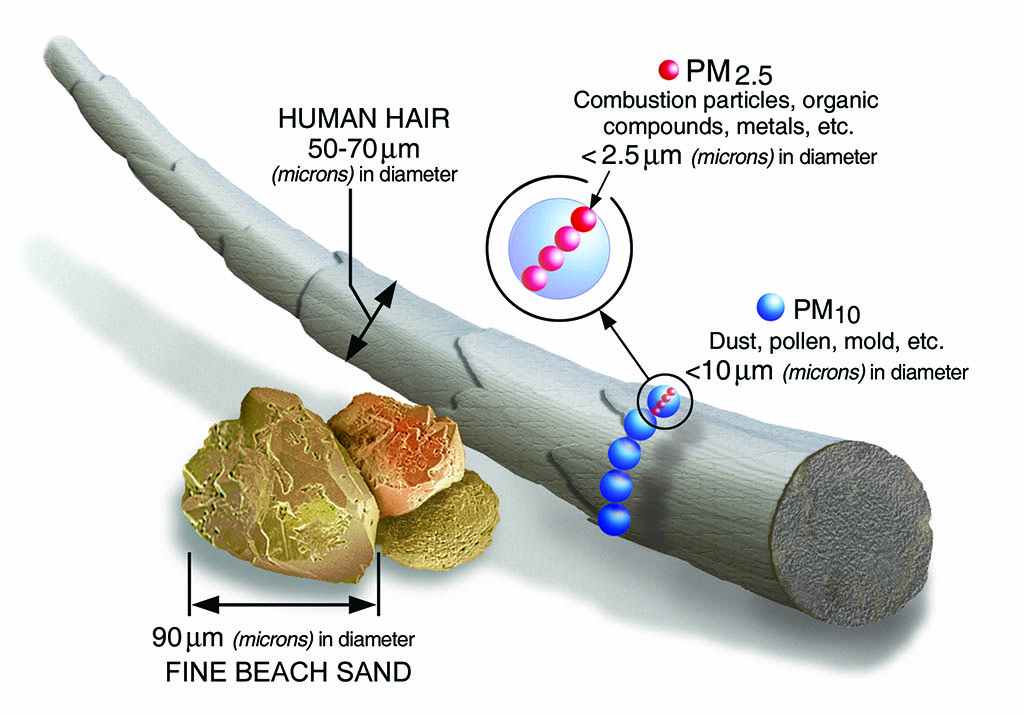To ensure you’re receiving the most up-to-date and accurate information, please choose the correct agency from the homepage. The DHEC website is no longer being updated and will be permanently unavailable Dec. 31, 2024.
Click here for the latest information, including the current smoke forecast for the community. The Able Contracting Information Hotline phone number is 803-898-4262 or 1-800‐204-1842.
Community Monitoring
DHEC deployed air sensors to evaluate the levels of fine particulate matter (PM2.5) in the surrounding community.
The sensors provide concentration data every 15 minutes. Please click here for real-time data from the air sensors. This data is used as an indicator for comparison to the level of the PM2.5 National Ambient Air Quality Standard. The Air Quality Index below provides information about the levels of particulate matter concentrations.
Water Quality Studies
As referenced in the August 16, 2019, update, recent samples taken in this watershed have identified elevated levels of fecal coliform bacteria. While not associated with the Able Contracting Fire, DHEC has commenced an assessment on ambient fecal coliform bacteria levels and potential source(s).
Additionally, DHEC has investigated potential off-site impacts from the Able Contacting Fire to surface waters in the Upper Okatie watershed. This second assessment addresses chemical inputs to water, sediment and biological tissue (oysters). Additionally, this assessment focuses on determination of analyte concentrations and associated source(s).
For complete details on sampling and analyses performed for the Okatee River Assessment, please read the entire report that can be found here:
Within the context of the chemical parametric coverages selected; the number of samples collected; and, the time period of sample collection, the overall data results demonstrated:
- The assessment results reported herein indicated that the Okatee River is not a pristine coastal river system. This has been indicated by a previous study (SCDHEC, SCDNR, & NOAA, 2000 - A Baseline Assessment of Environmental and Biological Conditions in Broad Creek and the Okatee River). Harvesting of shellfish in the general assessment area (SCDHEC Shellfish Harvesting Area 18) has been closed for a number of years based on deteriorated bacteriological conditions. Although not pristine, no chemical analyte data were reported that indicated issues of concern for human consumption of shellfish if in an otherwise open harvesting area. There were no issues of chemical contamination concern for human consumption of blue crabs harvested from the area.
- There was no discernible chemical signal in water, sediment or biological tissue, or discernible oyster ecology signal, of direct deleterious impact due solely and completely to the Able site.
Air Quality Index
| Air Quality | Who Needs to be Concerned? | What Should I Do? |
|---|---|---|
| Good 0 - 12 |
It’s a great day to be active outside. | It’s a great day to be active outside. |
| Moderate 12 - 35 |
Some people who may be unusually sensitive to particle pollution. | Unusually sensitive people: Consider reducing prolonged or heavy exertion. Watch for symptoms such as coughing or shortness of breath. These are signs to take it easier. Everyone else: It’s a good day to be active outside. |
| Unhealthy for Sensitive Groups 36 - 55 |
Sensitive groups include people with heart or lung disease, older adults, children and teenagers. |
Sensitive groups: Reduce prolonged or heavy exertion. It’s OK to be active outside, but take more breaks and do less intense activities. Watch for symptoms such as coughing or shortness of breath. People with asthma should follow their asthma action plans and keep quick relief medicine handy. If you have heart disease: Symptoms such as palpitations, shortness of breath, or unusual fatigue may indicate a serious problem. If you have any of these, contact your heath care provider. |
| Unhealthy 56 -150 |
Everyone |
Sensitive groups: Avoid prolonged or heavy exertion. Move activities indoors or reschedule to a time when the air quality is better. Everyone else: Reduce prolonged or heavy exertion. Take more breaks during all outdoor activities. |
| Very Unhealthy 151 -250 |
Everyone |
Sensitive groups: Avoid all physical activity outdoors. Move activities indoors or reschedule to a time when air quality is better. Everyone else: Avoid prolonged or heavy exertion. Consider moving activities indoors or rescheduling to a time when air quality is better. |
What Should You Do?
If smoke is visible, even if the source of the smoke is not, we recommend following these precautions:
- Avoid spending extended amounts of time in smoky conditions.
- Don’t walk, run, do yard work or participate in outdoor activities on days when smoke is visible at ground level.
People who have trouble breathing, experience an increase in coughing episodes, or have tightness in their chest should seek medical attention from their doctor or health care provider. People with asthma, chronic obstructive pulmonary disease (COPD) or emphysema are more likely than others to have these symptoms and should, when possible, not stay in smoky environments for long periods of time.
Particulate Matter
Particulate matter (PM) is made of solid particles and liquid droplets in the air.
EPA regulates two sizes of PM: PM10 and PM2.5. PM10 includes particles 10 micrometers in diameter and smaller. Most dust, fine soil, and smaller pollen and pores are included in PM10 measurements.
PM2.5, also called fine particulate, includes particles 2.5 micrometers in diameter and smaller. Fine soil and plant material is typically excluded from the measurement, leaving particles that are representative of smoke and haze.

Fact Sheets
These fact sheets were provided to residents and businesses near the fire: